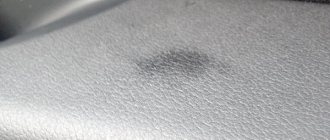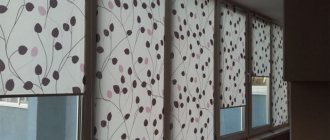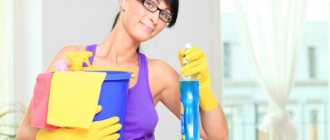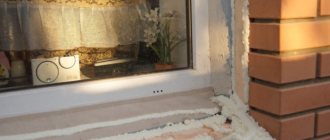Regular washing of plastic windows can significantly spoil the mood of the housewife.
Washing plastic, and even white plastic, is sometimes a thankless task, because with maximum effort you may not get any results at all. And vice versa - by following the simple recommendations of experienced housewives and window craftsmen, you can get an excellent result at a minimum of cost. Your windows will shine clean!
Why do mold spots appear?
To successfully cope with an unpleasant phenomenon, you need to know what it is.
Mold plaque is a fungus with an unusual structure. Under a microscope, it looks like a thin thread studded with balls. These are spores through which the body reproduces. It grows at the top, that is, it constantly stretches upward, scattering ripe spores. The biggest difficulty is that molds never live alone, only in groups. They are called colonies. Each of them strives to capture as much living space as possible, that is, to grow over the largest possible area. They do this especially well in conditions of high humidity and heating. A wet and warm environment stimulates rapid colony growth.
Fungus is a very unpleasant neighbor. Sometimes it is believed that its appearance is only an aesthetic problem. In fact, everything is much more serious. Fungal spores are a powerful allergen that provokes the appearance and further development of asthma, bronchitis, various manifestations of allergies, increasing the risk of oncology. Therefore, mold must be removed immediately. Moreover, while the colony is small, this is the easiest thing to do.
Mold appears where high humidity and temperatures above 15C combine. These are the best conditions for its development.
Causes
This:
- The installation of the window system was carried out with errors, as a result of which the double-glazed windows were depressurized.
- Lack or ineffective ventilation. Especially if the window sill and slopes are wide.
- Heavy thick curtains were chosen that do not let air through to the glass.
- Lack of ventilation, which disrupts natural air exchange.
- Seasonal changes in the microclimate in the room associated with active heating and irregular ventilation.
Plastic systems are sealed; micro-ventilation, as was the case with wooden ones, is impossible with them. Therefore, all the reasons described above inevitably lead to condensation. It accumulates in the corners of the frames, spreads along the window sill, and rises along the slope. If no measures are taken, mold will appear in the next stage.
How to wash plastic windows
You can wash a plastic window at home using both store-bought and homemade products. Both options help get rid of stains and dirt relatively quickly.
How to wash double-glazed windows
The following products help to clean windows without streaks:
- "Mister Muscle";
- "Formula 409";
- “Sanita” (effective in removing difficult stains);
- “Frosh” (removes polyurethane foam);
- “White Cat” (a rag soaked in a special compound can clean plastic and glass);
- "Mr. Proper" (used for washing from common types of dirt);
- gel "Comet" (capable of cleaning glass and plastic from grease).
To remove fresh stains, it is recommended to use dishwashing detergent or soapy water. To help get rid of marks on glass:
- lemon juice or acid;
- alcohol (1 tbsp per glass of water);
- table vinegar and ammonia (one tablespoon per glass of water);
- table vinegar and liquid soap (2 tbsp and 0.5 tsp per glass of water).
You can also wash glass using table vinegar (2 tbsp), potato starch (1 tbsp), salt (1 or 2 tbsp) or tooth powder (1 or 2 tbsp), mixed with a liter of warm water.
What to use to wash plastic
Cleaning plastic windows from dirt is not difficult if you use the following products:
- CLIN. An alcohol-containing liquid that can be used to remove old stains.
- CIF. Able to clean old stains and get rid of soot.
- Synergetic. A natural remedy that is effective on various types of dirt. Helps clean plastic windows without using abrasives.
Cif
Clin
Synergetic
Unlike glass, plastic under the influence of the external environment (mainly sunlight) acquires a yellow tint over time. Help to whiten PVC frames and window sills:
- Laundry soap. Half the bar must be dissolved in hot water. Then the resulting mixture must be applied to the yellow stains and left for half an hour. Finally, the plastic must be rinsed with plain water.
- Washing powder and soda. Both components in the amount of one tablespoon should be mixed in a liter of water. Then the product is applied to the problem area, left overnight and washed off. In the same way, you can wash the plastic frame from soot and soot.
- Hydrogen peroxide. To return the plastic to its white color, just wipe off the yellowness with this liquid.
It is not recommended to remove yellow stains with bleach, since some such detergents contain substances that corrode plastic. White spirit, medical alcohol (vodka) and soda mixed with water until creamy form help to clean the material from glue residues.
Recommendations for caring for PVC frames
To wash PVC frames, use almost the same products as for window sills, since the material being cleaned is homogeneous. If, after renovating an apartment, you have to wash the frames of newly installed windows, you must remove the protective film. Over time, it will stick and it will be difficult to remove it. After this, ordinary dirt is washed off with water with the addition of laundry soap, dishwashing liquid or washing powder. It is important that any composition does not contain acids or abrasives. Even new frames may show minor scratches. They can be easily hidden by treating the area with polish.
Store-bought care products for PVC frames
You can clean the PVC frame with the same “Mr. Proper" or similar products used for window sills. However, this list can be expanded a little:
- Domestos gel, specially developed for toilets and baths, can whiten yellowed frames;
- The basis of Pemolux cream is soda. It is safe for PVC surfaces and can easily clean stubborn dirt after repair;
- It is good to wash off grease from kitchen frames with Comet gel. When used, it is diluted at the rate of 60 ml of the drug per 5 liters of water;
- Mr Muscle cream will help whiten frames. The preparation is rubbed onto the PVC surface and washed off with a wet sponge after 3 minutes.
When using any chemical, you must remember safety precautions and use personal protective equipment.
Folk remedies for caring for PVC frames
You can clean PVC frames at home, as well as window sills, using folk remedies. Let's look at the two most popular recipes:
- Equal proportions of chalk and tooth powder are diluted with water to form a paste. This mixture is applied to a dirty surface and after drying, simply wiped with a dry soft cloth.
- To remove a stubborn stain, sprinkle it with baking soda and immediately rub it with a sponge soaked in vinegar. The reaction that occurs will clear out the dirt, after which the frame must be washed with clean water.
When using an unfamiliar folk remedy, you must first test it on a small area and then rub it on the entire frame.
How to properly wash plastic windows
Regardless of the chosen means and washing technique, when cleaning plastic windows, the following rules must be observed:
- Do not combine alcohol-containing cleaning agents with hot or warm water;
- Avoid using sharp objects to clean plastic surfaces;
- do not use chlorine and acetone-containing compounds, acids and solvents;
- do not use abrasive substances.
It is recommended to wash plastic windows, starting with double-glazed windows and ending with the frame and window sill. When choosing products, you should consider the type of stains that frequently appear. In addition, to clean a plastic window, you will need soft sponges, rags, paper towels and/or napkins.
Wash the double-glazed window so that there are no streaks
Plastic windows should be washed, starting with cleaning the sashes from dust, dirt and cobwebs. To do this, you can use dry rags and a vacuum cleaner. Next, wipe the glass with soapy water or water. After that:
- a cleaning gel or other product is added to the water (can be washed with either a store-bought or homemade solution) and the glass is wiped again from the inside;
- the upper, side, and then the lower sashes are washed from the inside and outside;
- using a telescopic mop, wipe the “solid” glass from the outside (you need to move from the far wall towards yourself);
- The glass is wiped with a dry cloth or paper towel.
To avoid streaks, it is recommended that after cleaning a plastic window, do not remove the applied solution with a napkin, but go over it with a solution of vinegar, ammonia and starch. This mixture should be applied to the surface with a spray bottle and washed with a damp cloth.
During the cleaning process, you should frequently change the water and rinse the napkin (sponge). At the end of the procedure, you can go over the glass again with a dampened cloth without using cleaning agents or soapy water.
We clean the frame and window sill from various contaminants
A quick way to wash plastic slopes, frames and window sills is to apply one of the following products to areas of contamination:
- "Mister proper";
- gel "Domestos";
- cleansing cream "Mr. Muscle";
- gel "Comet".
Do not wash plastic using gasoline, acetone or powdered detergents. It is recommended to clean the window sill and frame from the inside first, and then the outside.
Methods for removing rare types of contaminants (paint, polyurethane foam) are described above. It is recommended to wash greasy stains using dish soap or soap solution. These same products help get rid of the blackness that accumulates outside. In other cases you will need:
- vegetable oil or medical alcohol (remove traces of tape);
- half an onion (used to clean traces of flies);
- a mixture of ammonia and water (removes traces of unknown origin);
- rubbing alcohol (used to remove marker stains).
It is recommended to wash the plastic immediately after stains appear. Some substances are able to penetrate deep into the material, leaving behind indelible marks.
Without special devices
Experienced housewives know that washing a window does not mean polishing the glass until it shines; all parts of the structure deserve attention. You should start with preparation: remove curtains, nets, clear the window sill. Then proceed to the main part.
Step-by-step instruction:
Cleaning frames with soapy water. In case of severe contamination, it is necessary to use professional liquids.
- Removing dirt and stains from double-glazed windows. You can use a sponge with a special product, moving from top to bottom (repeat twice).
- Processing of glass and profile joints. The greatest amount of dirt accumulates there. Do not allow alcohol-based solution to come into contact with the seal.
- Rubbing glass. To avoid the formation of streaks on the glass, you must use a dry cloth or microfiber cloth.
- The final stage is the window sill. Even stubborn stains should not be removed with household chemicals with an aggressive composition.
How to remove primer
The primer left after the repair on the PVC inside and outside had to be removed immediately. To properly remove stubborn primer mixture, use the following methods.
- First, try washing the dirty areas with warm water and detergent and a stiff sponge.
- If you can't remove the primer, take vinegar essence and use it to wipe off any remaining stains from the glass, frame, and window sill. Wear gloves and a mask, the essence vapors are very caustic.
- Remove heavily ingrained primer with a blade, after moistening the remaining mixture. Place a wet rag over the marks and wait for the primer to swell. Then carefully scrape it off the glass and plastic with a blade.
- Baking soda applied to a damp, stiff sponge works great for removing primer marks.
Removing sticker marks
The sooner you start removing stickers from PVC, the better. The decisive factor here is the contact time of the sticker with the surface.
- When removing a sticker, don’t stop halfway. You need to tear it off with a quick movement and all at once. Then the stickers can be easily removed and will not leave stains.
- After removing the sticker, a small amount of glue remains on the plastic, which will collect dirt. To get rid of it, use the same dimexide.
- Vegetable oil works great for removing stickers. You should tear off the label and clean the contaminated area with a sponge with oil applied to it.
Products with chlorine
All chlorine-containing products perfectly bleach and remove any stains. With their help, you can remove yellowness from plastic in just a few minutes. However, chlorine is an aggressive substance, so it must be used carefully.
Sequence of operations:
- Wear gloves that will protect the skin of your hands from contact with chlorine.
- A few drops of the product are applied to a piece of fabric.
- Gently rub off the yellow stains, being careful not to touch the clean surface.
- After completing the work, immediately wash off the remaining composition.
How to clean a plastic window sill from stains and yellowness?
Yellow spots on a plastic window sill can appear for various reasons, and simply wiping will not be enough. You will have to use a detergent, or even more than one. One of the reasons for yellowness on plastic is indoor plants, when water spilled from the pan is not removed in time. Grease stains can also turn yellow if pots, plates of food, and bottles of vegetable oil are often placed on the windowsill.
It happens that the spots appear not yellow, but black. This is dust and dirt that over time penetrates the pores of the window sill. It is difficult to wash, and the use of brushes and abrasives is extremely undesirable.
A melamine sponge removes stains from plastic well. It works like an eraser and sweeps away dirt from porous surfaces.
Grease stains can be easily removed by a solution of water and ordinary laundry soap, which contains a large amount of alkali. The soap should be grated directly into a bucket of water and applied to the stains with a sponge.
A solution of vinegar and water in equal proportions will also help against stains on plastic. Pour it into a spray bottle and direct it onto the stain. After 10-15 minutes, remove the liquid with a sponge and wipe the area with a cloth soaked in water.
Cosmetics for cars
Automotive plastic has the same characteristics as household plastic. Thanks to this, they can be cleaned with the same product. In most cases, such compositions are produced in the form of a spray.
Step-by-step instruction:
- The selected substance is sprayed onto the plastic.
- It is left to dry for several tens of minutes.
- After this, wipe the surface with a cloth soaked in water.
Removing traces of tape
Scotch tape always leaves marks on window sills and glass that are difficult to get rid of. Tape stains that are not removed in time turn into stains of adhering dirt. Several ways to help answer the question of how to clean plastic windows from tape.
- Fight fire with fire. Take a new piece of tape and apply it to the stains from the old tape. Then quickly and sharply tear it off. Repeat the procedure until the tape marks disappear completely.
- You will need any vegetable oil. Apply it with a cotton pad to the tape stains and wait 10-15 minutes. Then wipe with paper towels.
- Remove tape stains with a simple eraser. It is enough to rub the areas with remaining tape well.
Traces of paint
On plastic, traces of paint are a serious problem that requires immediate removal. First, you need to resort to a gentle method, smearing the dried paint with silicate glue. As the glue dries, it will begin to shrink, pulling the bulk of the paint with it.
How to adjust plastic windows with your own hands if the sashes sag or there is draft from the windows.
If this does not help, take a piece of cotton wool, soak it in nail polish remover and wipe the painted area. It is important to pay attention that the liquid does not contain acetone. Otherwise, this substance will corrode the plastic.
Polyurethane foam
Sticking foam in the wrong place is a common occurrence after repairs. Cosmofen is sold specifically for PVC windows. Uncured foam is cleaned off with a plastic scraper, and the remaining stain is wiped off with a rag soaked in this solution.
Dry foam should be cut off as much as possible with a sharp knife, and the remaining stain should be moistened with Dimexide medical solution. After 5 minutes, loose residues are wiped off with the hard side of a dishwashing sponge.
The store sells special foam solvents. Before using them, you must carefully study the instructions, otherwise the aggressive solution will do more harm than good. The most harmless product for plastic and the skin of the hands is SOL OFF Delicat Barton'S.
Soot
On the street side, a lot of soot settles on PVC frames. It is formed during the operation of factories and from vehicle exhaust gases. Inside the room, soot settles from tobacco smoke and food burnt during cooking. A soap solution or baking soda will help get rid of it. They simply wipe the window, then rinse with clean water. You should not use aggressive anti-soot products.
Construction mud
After the renovation is completed, traces of cement, wallpaper paste or plaster remain on the windows. All these residues are easily washed off with soapy water. Very hard fractions can be pre-soaked in vinegar, then washed off.
Having cleared the window sills and frames of dirt, all that remains is to wipe off the glass. For this, there are many store-bought remedies such as “Second” or simply add ammonia to the water. Traditional crumpled newspaper will help add shine to glass.
Sorbent and ionizer
Household appliances can also help in the fight against fungus. An ionizer is a device that purifies the air from germs, bacteria, pathogenic organisms, etc. Small models are very convenient to use. The device is placed on the windowsill and turned on at high power, and after some time the minimum mode is set. The device is left on for about half an hour.
A sorbent is an aroma absorber. It is produced on an industrial scale to eliminate unpleasant odors in rooms. It will not be able to radically change the situation in the fight against mold, but its use will have a small effect.
How to remove blackness on windows and sides of walls?
We installed plastic windows and beauty began. As soon as the cold weather set in, blackness began to appear on the walls of the windows and on the windows themselves.
Blackness around windows is caused by fungus. In order to get rid of it, you first need to get rid of excess moisture in the room. To do this, you can use a desiccant; it is sold in hardware stores. You can also try drying the surface with a heater. After this, you need to treat the surface with an antifungal agent and then carry out cosmetic repairs.
Professional products
A huge variety of cleaning products for plastic products are produced by the chemical industry. Manufacturers of special cleaning sprays promise not only high-quality cleaning of surfaces, but also protection of all types of plastic from dirt, thanks to the protective film that forms after application.
The product in the form of various creams does not have abrasive components, so they will carefully clean and disinfect all plastic surfaces. Special pastes will not only clean the surface, but thanks to their polishing properties they will remove small scratches and resulting unevenness or roughness. To do this, it will be enough to apply a sufficient amount of paste onto a clean cotton napkin and rub into the desired surface with intense circular movements for 2-3 minutes.
Home methods for cleaning plastic windows
The best way to clean windows in a house is something every person should know, since this problem sooner or later affects all owners of their homes.
The following recommendations suggest how to clean plastic windows from contaminants such as mold, foam, soot, primer, cement, glass stickers and others:
- Alcohol removes stubborn stains that make new and old windows look much worse.
- A solution with washing powder and soda will be useful if the windows have turned yellow and the window slopes have also been damaged.
- Laundry soap is good at removing cement and plaster that remain after repairs.
- Toothpaste is ideal in the fight against such a nuisance as mold.
A person who knows how to remove film from plastic windows and other contaminants will be able to perfectly clean the problem area in the house.
Main causes of pollution
Most often, windows become very dirty during heavy rainfall.
Glass becomes dirty:
- Precipitation. After rain and snow, dirt appears on the horses, so the outside needs to be washed frequently.
- Dust. She sits down not only from the inside, but also from the street.
- With paint or glue, if repair work is being carried out: it is better to protect the glass with film.
As a result of temperature changes, streaks appear on the windows. Therefore, in order for them to become transparent again, they should be washed from contamination.











